Abstract
Actinobacillus actinomycetemcomitans produces an immunosuppressive factor (ISF) which has been shown to suppress mitogen- and antigen-induced DNA, RNA, and protein synthesis in human T lymphocytes. In this study, we examined purified A. actinomycetemcomitans ISF for its ability to alter immunoglobulin production by human B cells. The ISF caused a dose-dependent inhibition of pokeweed mitogen (PWM)-induced immunoglobulin G (IgG) and IgM production. Preexposure to ISF was not required to achieve maximal inhibition of immunoglobulin synthesis, as previously observed for its effect on T-cell activation. Nevertheless, the ISF appeared to act by irreversibly affecting the early stages of cell activation. While PWM-induced immunoglobulin production is under the influence of T-regulatory circuits, it appears that the ISF interacts directly with B cells. First, ISF failed to alter either the synthesis of interleukin-2 (IL-2) or the expression of IL-2 receptors on T cells. Second, experiments in which individual purified populations of cells were exposed to ISF, washed, and placed back into tissue culture indicated that when all cells (i.e., T cells, B cells, and monocytes) were exposed to ISF, significant suppression was observed. However, when only one cell population was treated with ISF, suppression of both IgG and IgM synthesis was observed only when the B-cell-enriched population was exposed to ISF. These results in conjunction with our earlier findings suggest that the ISF functions via the activation of a regulatory subpopulation of B lymphocytes, which in turn either directly or indirectly (via suppressor T cells) downregulate both B- and T-cell responsiveness. Furthermore, it is hypothesized that patients who harbor A. actinomycetemcomitans could suffer from local or systemic immune suppression. This suppression may enhance the pathogenicity of A. actinomycetemcomitans itself or that of some other opportunistic organism.
Full text
PDF
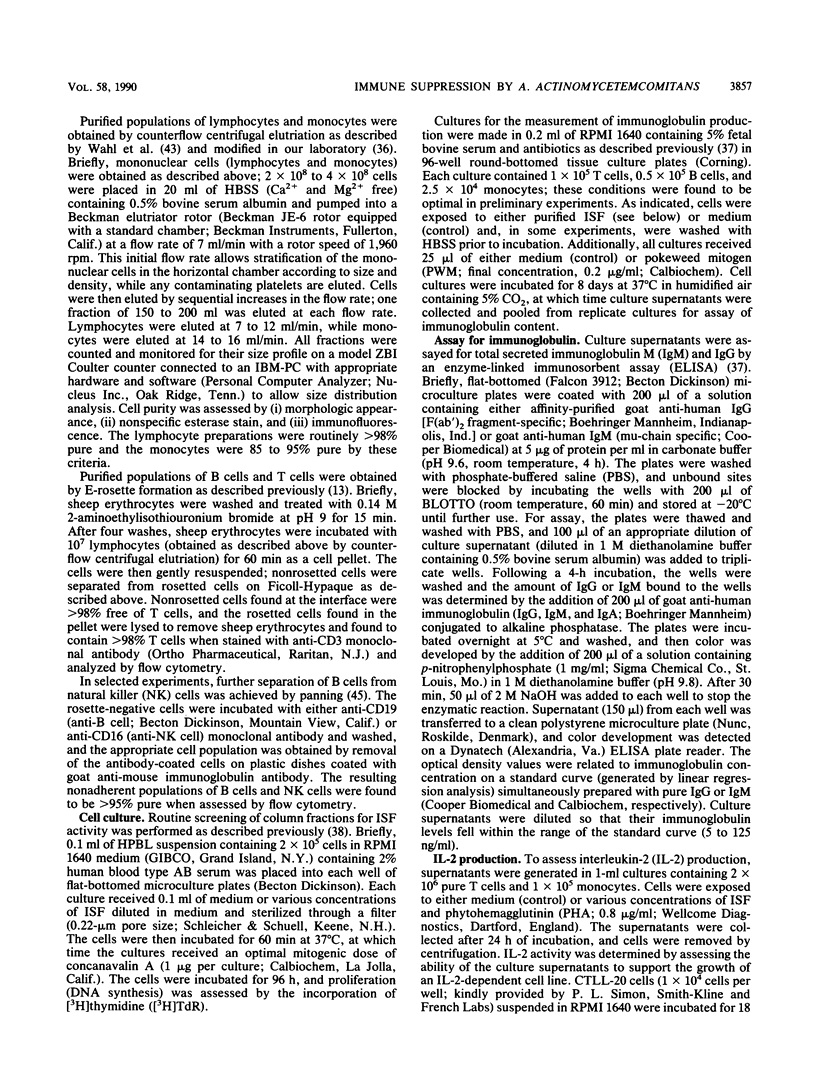
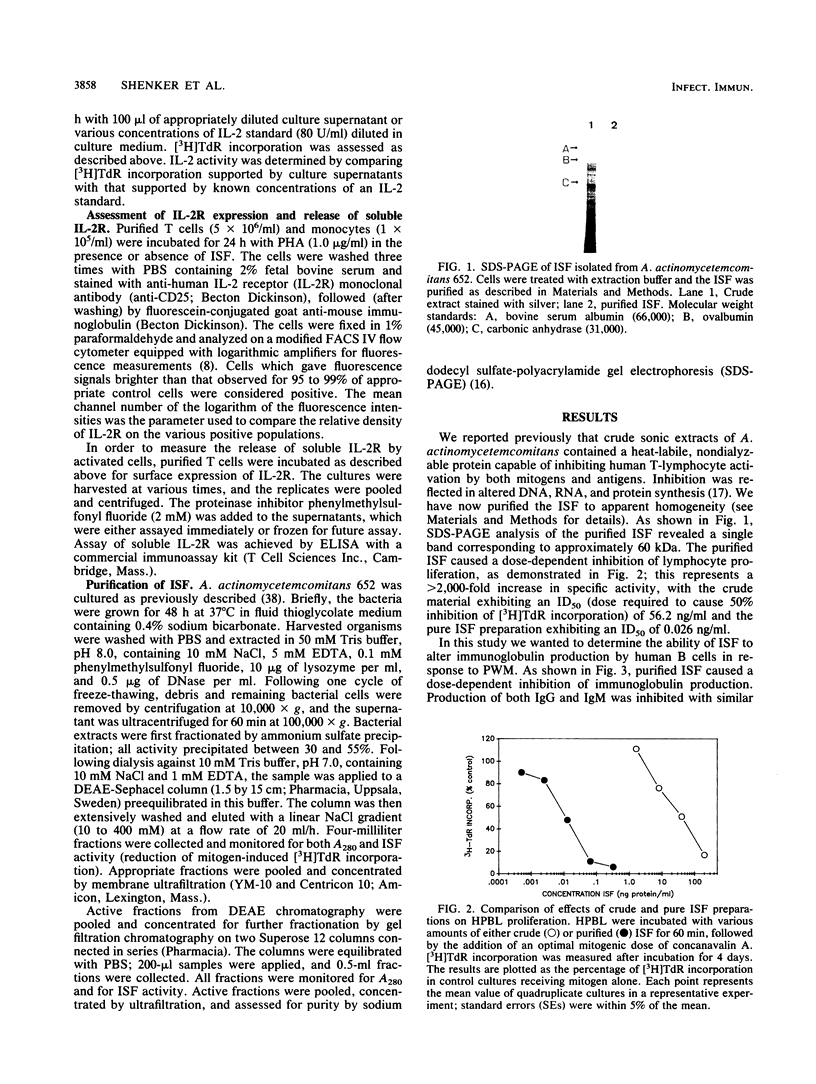
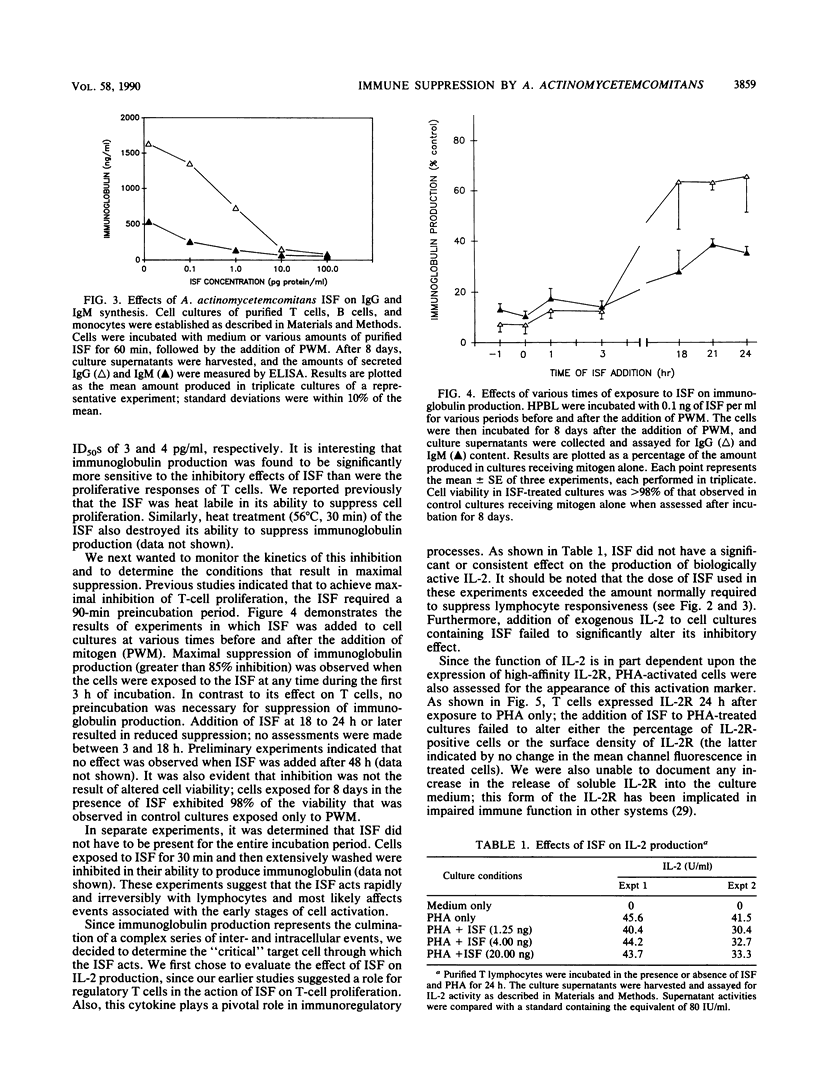
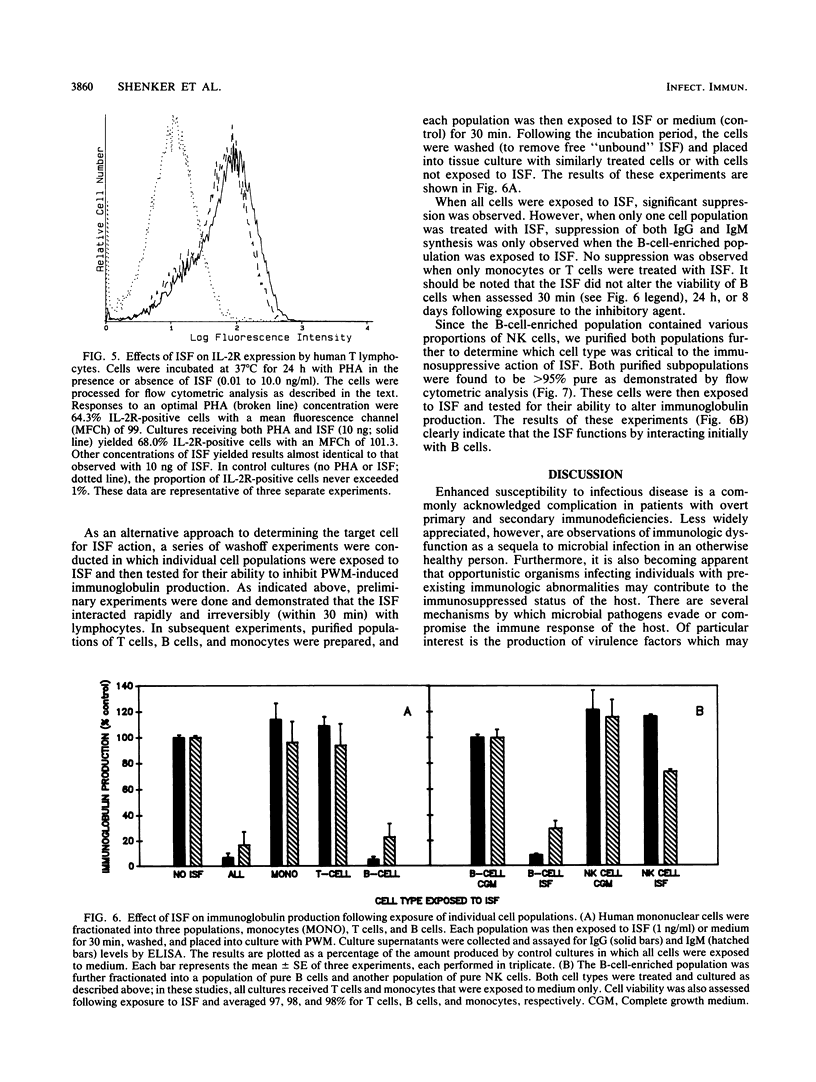
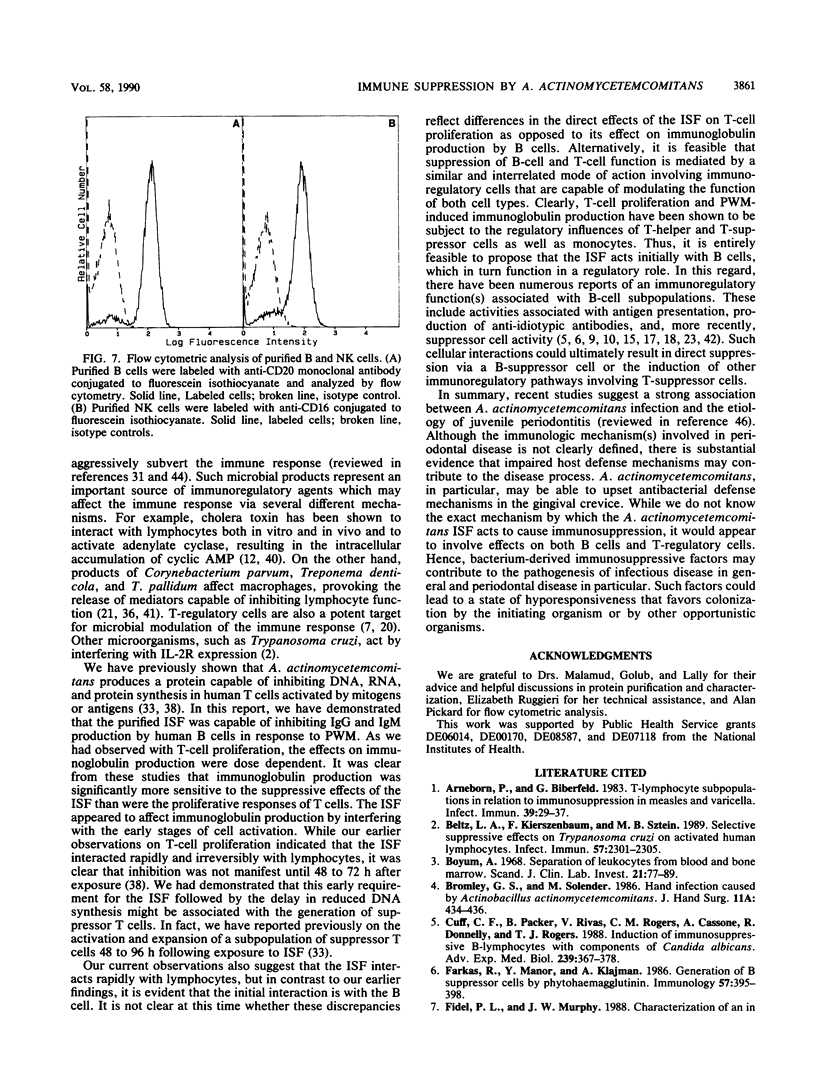
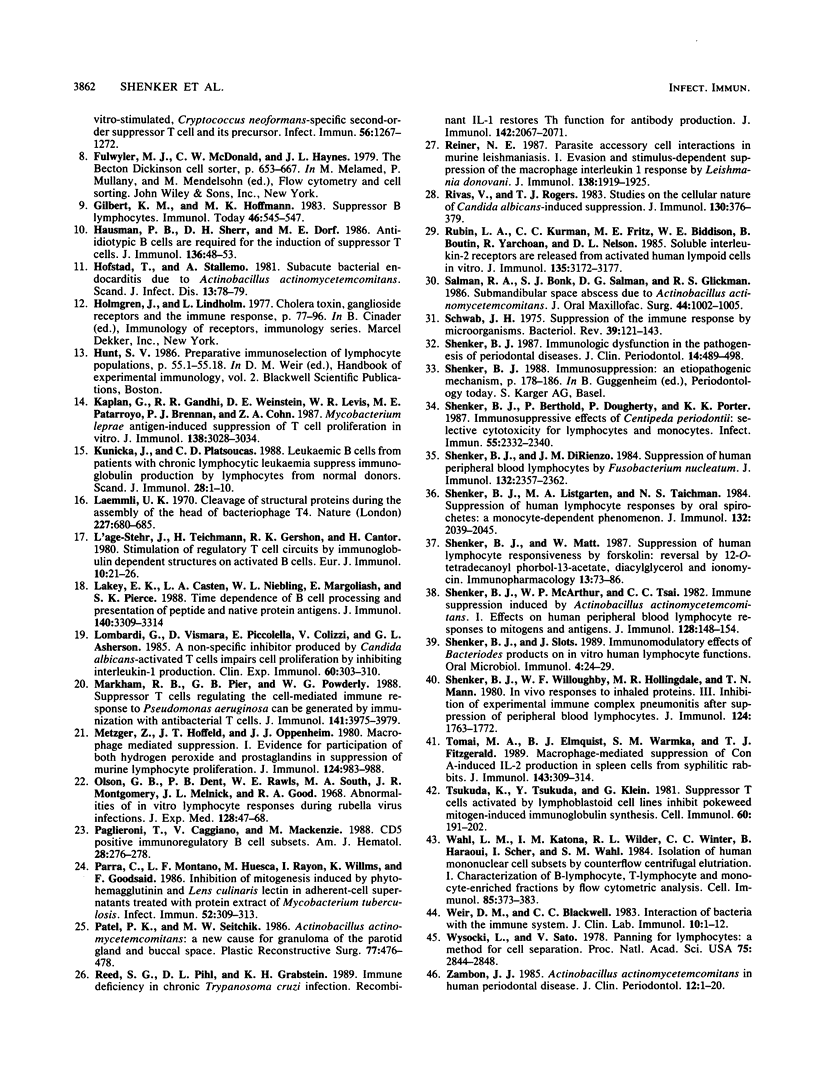
Images in this article
Selected References
These references are in PubMed. This may not be the complete list of references from this article.
- Arneborn P., Biberfeld G. T-lymphocyte subpopulations in relation to immunosuppression in measles and varicella. Infect Immun. 1983 Jan;39(1):29–37. doi: 10.1128/iai.39.1.29-37.1983. [DOI] [PMC free article] [PubMed] [Google Scholar]
- Beltz L. A., Kierszenbaum F., Sztein M. B. Selective suppressive effects of Trypanosoma cruzi on activated human lymphocytes. Infect Immun. 1989 Aug;57(8):2301–2305. doi: 10.1128/iai.57.8.2301-2305.1989. [DOI] [PMC free article] [PubMed] [Google Scholar]
- Bromley G. S., Solender M. Hand infection caused by Actinobacillus actinomycetemcomitans. J Hand Surg Am. 1986 May;11(3):434–436. doi: 10.1016/s0363-5023(86)80159-9. [DOI] [PubMed] [Google Scholar]
- Cuff C. F., Packer B., Rivas V., Rogers C. M., Cassone A., Donnelly R., Rogers T. J. Induction of immunosuppressive B-lymphocytes with components of Candida albicans. Adv Exp Med Biol. 1988;239:367–378. doi: 10.1007/978-1-4757-5421-6_35. [DOI] [PubMed] [Google Scholar]
- Farkas R., Manor Y., Klajman A. Generation of B suppressor cells by phytohaemagglutinin. Immunology. 1986 Mar;57(3):395–398. [PMC free article] [PubMed] [Google Scholar]
- Hausman P. B., Sherr D. H., Dorf M. E. Anti-idiotypic B cells are required for the induction of suppressor T cells. J Immunol. 1986 Jan;136(1):48–53. [PubMed] [Google Scholar]
- Hofstad T., Stallemo A. Subacute bacterial endocarditis due to Actinobacillus actinomycetemcomitans. Scand J Infect Dis. 1981;13(1):78–79. doi: 10.1080/00365548.1981.11690372. [DOI] [PubMed] [Google Scholar]
- Kaplan G., Gandhi R. R., Weinstein D. E., Levis W. R., Patarroyo M. E., Brennan P. J., Cohn Z. A. Mycobacterium leprae antigen-induced suppression of T cell proliferation in vitro. J Immunol. 1987 May 1;138(9):3028–3034. [PubMed] [Google Scholar]
- Kunicka J., Platsoucas C. D. Leukaemic B cells from patients with chronic lymphocytic leukaemia suppress immunoglobulin production by lymphocytes from normal donors. Scand J Immunol. 1988 Jul;28(1):1–10. doi: 10.1111/j.1365-3083.1988.tb02409.x. [DOI] [PubMed] [Google Scholar]
- L'age-Stehr J., Teichmann H., Gershon R. K., Cantor H. Stimulation of regulatory T cell circuits by immunoglobulin-dependent structures on activated B cells. Eur J Immunol. 1980 Jan;10(1):21–26. doi: 10.1002/eji.1830100105. [DOI] [PubMed] [Google Scholar]
- Laemmli U. K. Cleavage of structural proteins during the assembly of the head of bacteriophage T4. Nature. 1970 Aug 15;227(5259):680–685. doi: 10.1038/227680a0. [DOI] [PubMed] [Google Scholar]
- Lakey E. K., Casten L. A., Niebling W. L., Margoliash E., Pierce S. K. Time dependence of B cell processing and presentation of peptide and native protein antigens. J Immunol. 1988 May 15;140(10):3309–3314. [PubMed] [Google Scholar]
- Lombardi G., Vismara D., Piccolella E., Colizzi V., Asherson G. L. A non-specific inhibitor produced by Candida albicans activated T cells impairs cell proliferation by inhibiting interleukin-1 production. Clin Exp Immunol. 1985 May;60(2):303–310. [PMC free article] [PubMed] [Google Scholar]
- Markham R. B., Pier G. B., Powderly W. G. Suppressor T cells regulating the cell-mediated immune response to Pseudomonas aeruginosa can be generated by immunization with anti-bacterial T cells. J Immunol. 1988 Dec 1;141(11):3975–3979. [PubMed] [Google Scholar]
- Metzger Z., Hoffeld J. T., Oppenheim J. J. Macrophage-mediated suppression. I. Evidence for participation of both hdyrogen peroxide and prostaglandins in suppression of murine lymphocyte proliferation. J Immunol. 1980 Feb;124(2):983–988. [PubMed] [Google Scholar]
- Mogensen C. E. The glomerular permeability determined by dextran clearance using Sephadex gel filtration. Scand J Clin Lab Invest. 1968;21(1):77–82. doi: 10.3109/00365516809076979. [DOI] [PubMed] [Google Scholar]
- Olson G. B., Dent P. B., Rawls W. E., South M. A., Montgomery J. R., Melnick J. L., Good R. A. Abnormalities of in vitro lymphocyte responses during rubella virus infections. J Exp Med. 1968 Jul 1;128(1):47–68. doi: 10.1084/jem.128.1.47. [DOI] [PMC free article] [PubMed] [Google Scholar]
- Paglieroni T., Caggiano V., MacKenzie M. CD5 positive immunoregulatory B cell subsets. Am J Hematol. 1988 Aug;28(4):276–278. doi: 10.1002/ajh.2830280413. [DOI] [PubMed] [Google Scholar]
- Parra C., Montaño L. F., Huesca M., Rayón I., Willms K., Goodsaid F. Inhibition of mitogenesis induced by phytohemagglutinin and Lens culinaris lectin in adherent-cell supernatants treated with protein extract of Mycobacterium tuberculosis. Infect Immun. 1986 Apr;52(1):309–313. doi: 10.1128/iai.52.1.309-313.1986. [DOI] [PMC free article] [PubMed] [Google Scholar]
- Patel P. K., Seitchik M. W. Actinobacillus actinomycetemcomitans: a new cause for granuloma of the parotid gland and buccal space. Plast Reconstr Surg. 1986 Mar;77(3):476–478. [PubMed] [Google Scholar]
- Reed S. G., Pihl D. L., Grabstein K. H. Immune deficiency in chronic Trypanosoma cruzi infection. Recombinant IL-1 restores Th function for antibody production. J Immunol. 1989 Mar 15;142(6):2067–2071. [PubMed] [Google Scholar]
- Reiner N. E. Parasite accessory cell interactions in murine leishmaniasis. I. Evasion and stimulus-dependent suppression of the macrophage interleukin 1 response by Leishmania donovani. J Immunol. 1987 Mar 15;138(6):1919–1925. [PubMed] [Google Scholar]
- Rivas V., Rogers T. J. Studies on the cellular nature of Candida albicans-induced suppression. J Immunol. 1983 Jan;130(1):376–379. [PubMed] [Google Scholar]
- Rubin L. A., Kurman C. C., Fritz M. E., Biddison W. E., Boutin B., Yarchoan R., Nelson D. L. Soluble interleukin 2 receptors are released from activated human lymphoid cells in vitro. J Immunol. 1985 Nov;135(5):3172–3177. [PubMed] [Google Scholar]
- Salman R. A., Bonk S. J., Salman D. G., Glickman R. S. Submandibular space abscess due to Actinobacillus actinomycetemcomitans. J Oral Maxillofac Surg. 1986 Dec;44(12):1002–1005. doi: 10.1016/s0278-2391(86)80055-6. [DOI] [PubMed] [Google Scholar]
- Schwab J. H. Suppression of the immune response by microorganisms. Bacteriol Rev. 1975 Jun;39(2):121–143. doi: 10.1128/br.39.2.121-143.1975. [DOI] [PMC free article] [PubMed] [Google Scholar]
- Shenker B. J., Berthold P., Dougherty P., Porter K. K. Immunosuppressive effects of Centipeda periodontii: selective cytotoxicity for lymphocytes and monocytes. Infect Immun. 1987 Oct;55(10):2332–2340. doi: 10.1128/iai.55.10.2332-2340.1987. [DOI] [PMC free article] [PubMed] [Google Scholar]
- Shenker B. J., DiRienzo J. M. Suppression of human peripheral blood lymphocytes by Fusobacterium nucleatum. J Immunol. 1984 May;132(5):2357–2362. [PubMed] [Google Scholar]
- Shenker B. J. Immunologic dysfunction in the pathogenesis of periodontal diseases. J Clin Periodontol. 1987 Oct;14(9):489–498. doi: 10.1111/j.1600-051x.1987.tb00989.x. [DOI] [PubMed] [Google Scholar]
- Shenker B. J., Listgarten M. A., Taichman N. S. Suppression of human lymphocyte responses by oral spirochetes: a monocyte-dependent phenomenon. J Immunol. 1984 Apr;132(4):2039–2045. [PubMed] [Google Scholar]
- Shenker B. J., Matt W. C. Suppression of human lymphocyte responsiveness by forskolin: reversal by 12-O-tetradecanoyl phorbol 13-acetate, diacylglycerol and ionomycin. Immunopharmacology. 1987 Feb;13(1):73–86. doi: 10.1016/0162-3109(87)90028-2. [DOI] [PubMed] [Google Scholar]
- Shenker B. J., McArthur W. P., Tsai C. C. Immune suppression induced by Actinobacillus actinomycetemcomitans. I. Effects on human peripheral blood lymphocyte responses to mitogens and antigens. J Immunol. 1982 Jan;128(1):148–154. [PubMed] [Google Scholar]
- Shenker B. J., Slots J. Immunomodulatory effects of Bacteroides products on in vitro human lymphocyte functions. Oral Microbiol Immunol. 1989 Mar;4(1):24–29. doi: 10.1111/j.1399-302x.1989.tb00402.x. [DOI] [PubMed] [Google Scholar]
- Shenker B. J., Willoughby W. F., Hollingdale M. R., Mann T. N. In vivo responses to inhaled proteins. III. Inhibition of experimental immune complex pneumonitis after suppression of peripheral blood lymphocytes. J Immunol. 1980 Apr;124(4):1763–1772. [PubMed] [Google Scholar]
- Tomai M. A., Elmquist B. J., Warmka S. M., Fitzgerald T. J. Macrophage-mediated suppression of con A-induced IL-2 production in spleen cells from syphilitic rabbits. J Immunol. 1989 Jul 1;143(1):309–314. [PubMed] [Google Scholar]
- Tsukuda K., Tsukuda Y., Klein G. Suppressor T cells activated by lymphoblastoid cell lines inhibit pokeweed mitogen-induced immunoglobulin synthesis. Cell Immunol. 1981 May 1;60(1):191–202. doi: 10.1016/0008-8749(81)90259-8. [DOI] [PubMed] [Google Scholar]
- Wahl L. M., Katona I. M., Wilder R. L., Winter C. C., Haraoui B., Scher I., Wahl S. M. Isolation of human mononuclear cell subsets by counterflow centrifugal elutriation (CCE). I. Characterization of B-lymphocyte-, T-lymphocyte-, and monocyte-enriched fractions by flow cytometric analysis. Cell Immunol. 1984 May;85(2):373–383. doi: 10.1016/0008-8749(84)90251-x. [DOI] [PubMed] [Google Scholar]
- Weir D. M., Blackwell C. C. Interaction of bacteria with the immune system. J Clin Lab Immunol. 1983 Jan;10(1):1–12. [PubMed] [Google Scholar]
- Wysocki L. J., Sato V. L. "Panning" for lymphocytes: a method for cell selection. Proc Natl Acad Sci U S A. 1978 Jun;75(6):2844–2848. doi: 10.1073/pnas.75.6.2844. [DOI] [PMC free article] [PubMed] [Google Scholar]
- Zambon J. J. Actinobacillus actinomycetemcomitans in human periodontal disease. J Clin Periodontol. 1985 Jan;12(1):1–20. doi: 10.1111/j.1600-051x.1985.tb01348.x. [DOI] [PubMed] [Google Scholar]



